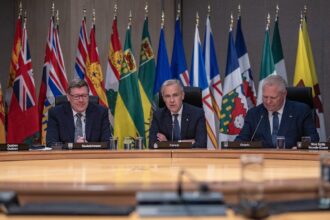In a significant development that has sent ripples through North American economic circles, Canada has stepped back from the negotiating table with the United States, citing that a “viable trade deal wasn’t on the table” as key deadlines approached. The revelation from Canada’s Trade Minister Mary Ng marks a notable bump in what many had hoped would be a smooth continuation of the historically strong trade relationship between the two nations.
“We simply couldn’t accept terms that would disadvantage Canadian workers and businesses,” Minister Ng stated during a press briefing in Ottawa yesterday. “While we remain committed to fair and balanced trade with our American partners, the proposals presented failed to address several critical concerns for our economy.”
The breakdown in negotiations comes at a particularly sensitive time for Canadian politics, with Prime Minister Justin Trudeau’s government facing increasing pressure to deliver economic wins ahead of anticipated elections. Sources close to the talks indicate that disagreements centered primarily around agricultural subsidies, softwood lumber tariffs, and digital services taxation—issues that have repeatedly created friction in the Canada-US trade relationship.
Economic analysts at the Royal Bank of Canada estimate that the stalled negotiations could impact approximately $2.5 billion in cross-border trade if alternative arrangements aren’t established promptly. “This isn’t just about numbers on spreadsheets,” explained Dr. Amrita Singh, senior economist at the Canadian Centre for Policy Alternatives. “We’re talking about real implications for supply chains that thousands of businesses on both sides of the border rely upon.”
The U.S. Trade Representative’s office responded with measured language, stating that “discussions continue through diplomatic channels” while emphasizing America’s desire for “fair and reciprocal trading relationships.” However, industry insiders suggest the atmosphere has cooled considerably between the negotiating teams.
For Canadian businesses particularly in the manufacturing, agriculture, and technology sectors, this development introduces unwelcome uncertainty. The Toronto Stock Exchange reflected this concern with modest declines in companies heavily dependent on cross-border commerce, while the Canadian dollar weakened slightly against its American counterpart in yesterday’s trading.
“What we’re witnessing is the practical reality of asymmetric trade relationships,” noted Professor Thomas Courchene of Queen’s University. “Canada, with its smaller economic footprint, must carefully balance assertiveness with pragmatism when dealing with its largest trading partner.”
The impasse appears particularly problematic given the broader context of global trade disruptions and supply chain vulnerabilities exposed during the pandemic. Experts from the C.D. Howe Institute suggest that both countries would benefit from quickly resolving these differences rather than allowing them to fester.
Minister Ng emphasized that Canada remains “at the table” and ready to resume substantive discussions when conditions improve. “This isn’t about walking away—it’s about ensuring that when we sign, the agreement truly serves Canadians across all sectors and regions.”
As both nations navigate this challenging diplomatic terrain, the question remains: Can Canada and the United States overcome their differences to forge a trade relationship that balances national interests with the undeniable benefits of integrated North American commerce, or are we witnessing the beginning of a more protectionist era in cross-border relations?










